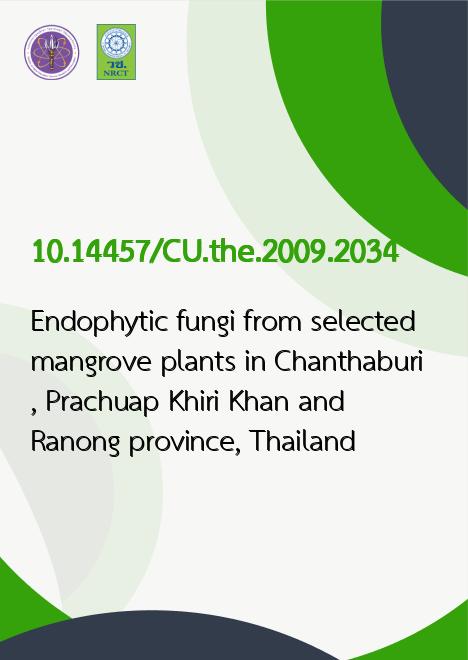
|
Endophytic fungi from selected mangrove plants in Chanthaburi, Prachuap Khiri Khan and Ranong province, Thailand |
|---|---|
| รหัสดีโอไอ | |
| Title | Endophytic fungi from selected mangrove plants in Chanthaburi, Prachuap Khiri Khan and Ranong province, Thailand |
| Creator | Sukanyanee Chaeprasert |
| Contributor | Prakitsin Sihanonth, Whalley, Anthony J.S. |
| Publisher | Chulalongkorn University |
| Publication Year | 2552 |
| Keyword | Endophytic fungi, Mangrove plants |
| Abstract | Compare endophytic fungi distribution in the mangrove leaf forest trees growing in three different locations (Kung Krabaen bay; Chanthaburi Province, Pranburi forest park; Prachuapkhirikhan Province and Ranong Biosphere Reserve; Ranong Province) in Thailand. Three thousand and nine hundred leaf segments from ten different hosts belonging to seven families, Rhizophoraceae (Rhizophora apiculata, R. mucronata, Ceriops decandra), Sonneratiaceae (Sonneratia alba), Combretaceae (Lumnitzera littorea) Avicenniaceae (Avicennia alba), Acanthaceae (Acanthus ilicifotius), Meliaceae (Xylocarpus granatum and Xylocarpus moluccensis) and Malvaceae (Thespesia populneoides), were screened for the presence of fungal endophytes. One thousand nine hundred and sixty five fungal endophyte isolates were isolated. Dominant species isolated from Chanthaburi were the genus Phyllosticta and it was also the dominant genus in R. apicula and C. decandra growing in the Prachuap Khiri Khan site. Morever this species was found the dominant isolates in A. Ilicifotius and X. moluccensis The dominant endophytic species of T. populneoides was Phoma. The dominant endophytic species in mangrove plants from Ranong Province were different for each host plant in the mangrove community. Species of Cladosporium was the dominant in R. apiculata whereas Pestalotiopsis was the dominant in R. mucronata. It was found the species of Glomerella as the dominant fungal endophyte in X. granatum. The endophytic assemblages of the mangrove trees were composed of a number of species such as Cladosporium Colletotrichum Daldinia Pestalotiopsis Phomopsis and Xylaria. One hundred and sixty eight endophytic fungal isolates were successfully amplified by using primer ITS3 and ITS 4 and then were grouped based on ITS region size. Each representative was selected for DNA sequence analysis using the whole ITS region, including ITS1, 5.8S, and ITS2. BLAST search in GenBank showed that all the rDNA ITS sequences could be grouped within the fungi domain. Our study also showed that molecular identification based on ITS sequences and phylogenetic relationships analysis can be used to complement or verify morphological identification of unknown endophytes and mycelium sterilia. The antimicrobial potential activity of 71 endophytic fungi were tested with selected bacteria (Bacillus subtilis ATCC 6633, Pseudomonas aeruginosa ATCC 27853, Escherichia coli ATCC 25922, Staphylococcus aureus ATCC 25923, Saccharomyces cerevisiae ATCC 5169 and Candida albicans ATCC 10231) by using ethyl acetate crude extracts fungal mycelia cultivated under static conditions. All test bacteria and yeast were inhibited by a Cladosporium sp. P1 isolated from the leaves of T. populneoides. Additionally eighty four endophytic fungal crude extracts were tested for anticancer activities by the MTT assay against A375 ATCC CRL-1619 (Human malignant melanoma), SW620 ATCC CCL-227 (Human colorectal adenocarcinoma), Kato III ATCC HTB-103 (Human gastric carcinoma), HepG2 ATCC HB-8065 (Human liver hepatoblastoma) and Jurkat ATCC CRL-2063 (Human acute T cell leukemia). Seven endophyte isolates acted as specific anticancer activities against Jurkat cells with cell viability below 40%. Phomopsis sp. R2 was isolated from A. ilicifotiusR displayed specific inhibition with Human colorectal adenocarcinoma (9.82%) |
| URL Website | cuir.car.chula.ac.th |